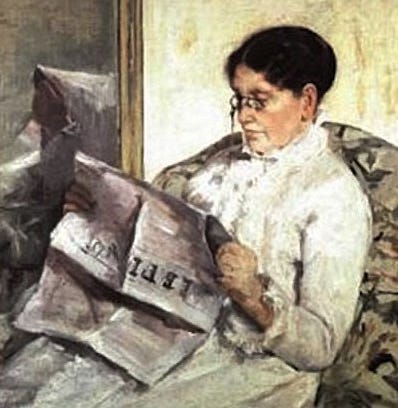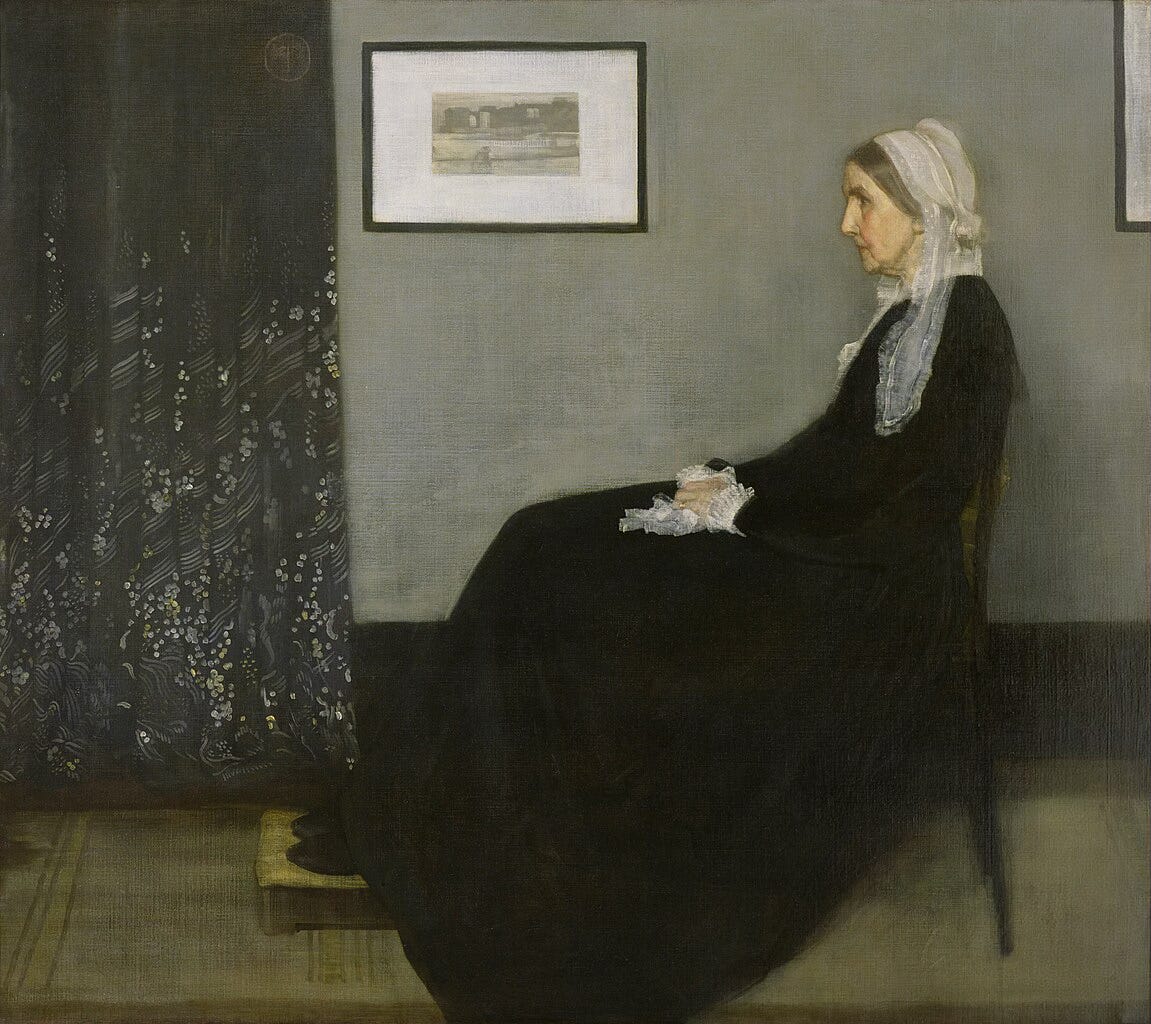Mary Cassatt (Art Drop #9)
"Whistler's Mother" may be one of the best known portraits in the world, but I'll take Cassatt's mom any day.

The US Post Office has issued several stamps honoring American Impressionist Mary Cassatt. There’s the 5-cent Boating Party stamp of 1966. The 23-cent stamp featuring a portrait of the artist in 1988. And there’s the $37-cent stamp-collection of 2003, which includes several other wonderful Cassatt paintings.
But not her poignant and pointed Reading Le Figaro, which is sometimes known as Portrait of a Lady (The Artists’s Mother Reading Le Figaro).
If Ken Jennings floated a Jeopardy! clue asking for the most famous 19th-century mom-painting in the world, most of us would buzz-in fast with “What is Whistler’s Mother?” And that would probably be the right answer—unless the judges disapproved. Because the actual name of Whistler’s famous painting is Arrangement in Grey and Black No.1.

Whistler’s mom was not uppermost in his mind as he painted that well-known portrait.
He was interested in the juxtaposition of form and color. One unverifiable story says his mother posed for the painting because his chosen model failed to show up. Another says his mom is sitting, supposedly, because he didn’t think she could stand up for a long time.
Regardless of what Whistler had in mind, he left us an image of motherhood that persisted well past the Victorian Age when women were seen as belonging to the domestic class. Their job was to take care of the children and keep a tidy house. Sound familiar?
In Victorian England, women lost control of their “wages, all physical property except land, and all other cash earned after marriage.” Everything went to those lucky so-and-sos, the husbands.
So inured was this idea of women and moms that Whistler’s mother (Anna McNeill Whistler) was even celebrated in the United States when the Post Office issued a 1934 three-cent stamp with a copy of his painting and the words, “In memory and in honor of the mothers of America."
That painting has been parodied, spoofed and satirized by countless imitators, from Mr. Bean to The Simpsons to photographer Aline Smithson, to name just a few.
Mary Cassatt’s mother, on the other hand
was very much in her mind when she painted her mom. Only seven years had passed between the two portraits. Women in 19th-century France, where Cassatt lived, were not much better off than the Victorians of the same period. In the words of one progressive French anarchist: women were only suited to be “housewives or harlots.”
But Mary Cassatt depicts her mother reading Le Figaro, a newspaper usually read by men of that period. Her intention was to portray her mother (Katherine Kelso Johnston) as an individual “who was not a traditional female figure but someone with advanced views on what women should concern themselves with.”
Mary Cassatt also painted some of the loveliest and most affecting mother-and-child paintings in art history. Although those works depict moms lovingly bathing, breastfeeding, and otherwise tending to their children, the portrait of her own mother reading Le Figaro acknowledges the source of her own personal power and attitude toward life. Her mother, who was educated and well-read, had a profound influence on her.
Invited to join the Impressionists in 1877 by Edgar Degas, she was the only American officially associated with the group. Her paintings were included in four of the eight Impressionists’ exhibits between 1879 and 1886.
I offer today’s Art Drop in celebration of Women’s History Month. But this post is also meant to honor and celebrate my own mother, the sine qua non. She was an avid reader who taught her children to love reading before we ever set foot in a classroom. She was an independent thinker and a tireless debater. She was also unafraid to challenge outdated ideas and the stuffy morons who tried to pass them off as truth. This one’s for you, Mom. Thank you!
For more on Mary Cassatt, check out the 90-second video clip below.
©2024 Andrew Jazprose Hill
Thanks for reading.




Mary Cassatt has long been one of my favorite artists - her mother and child paintings are beautiful, but I do love Reading Le Figaro. I love how the mirror in the painting only reflected the paper and not her mother. I never noticed that before, but thanks to one of the links in your piece, I understand the importance of that (given women’s struggles of that time). I say it every time, but I do enjoy your weekly Art Drops!
Thanks Andrew for sharing the story of Mary Cassatt and your heartfelt and very accurate reflection of mom! ( I'm sure some of my litigation skills came from her!!) Cassatt is one of my favorite artists! Judy and I visited the Electra Havemeyer Webb Museum in Shelburne, Vermont which has a very impressive collection of her works. Also, Judy really liked Cassatt's "The Child's Bath" printed on the cover. of one of her nursing books. Impressive, Impressionist!